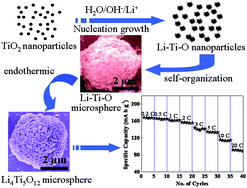Facile synthesis of hierarchically porous Li4Ti5O12 microspheres for high rate lithium ion batteries†
Abstract
A novel approach has been developed to synthesize hierarchically porous Li4Ti5O12 microspheres assembled by well-crystalline

* Corresponding authors
a
College of Material Science & Engineering, Nanjing University of Aeronautics and Astronautics, Nanjing, P. R. China
E-mail:
azhangxg@163.com
Fax: +86 025 52112626
Tel: +86 025 52112918
b School of Material Science & Engineering, Anhui University of Technology, Maanshan, P. R. China
c Department of Chemistry, Fudan University, Shanghai, P. R.China
A novel approach has been developed to synthesize hierarchically porous Li4Ti5O12 microspheres assembled by well-crystalline

 Please wait while we load your content...
Something went wrong. Try again?
Please wait while we load your content...
Something went wrong. Try again?
L. Shen, C. Yuan, H. Luo, X. Zhang, K. Xu and Y. Xia, J. Mater. Chem., 2010, 20, 6998 DOI: 10.1039/C0JM00348D
To request permission to reproduce material from this article, please go to the Copyright Clearance Center request page.
If you are an author contributing to an RSC publication, you do not need to request permission provided correct acknowledgement is given.
If you are the author of this article, you do not need to request permission to reproduce figures and diagrams provided correct acknowledgement is given. If you want to reproduce the whole article in a third-party publication (excluding your thesis/dissertation for which permission is not required) please go to the Copyright Clearance Center request page.
Read more about how to correctly acknowledge RSC content.
 Fetching data from CrossRef.
Fetching data from CrossRef.
This may take some time to load.
Loading related content
